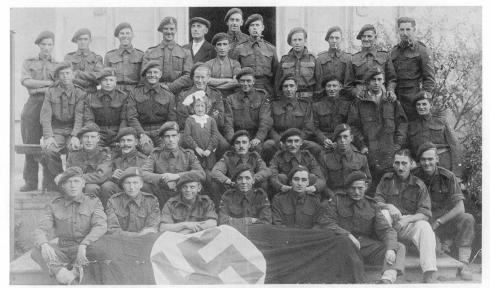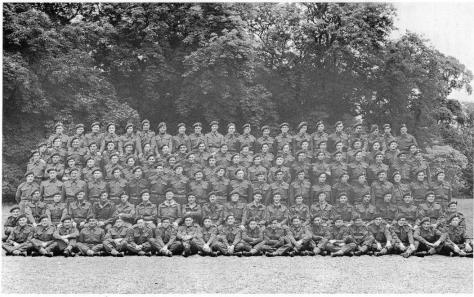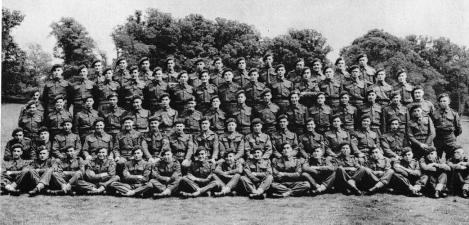
Plate 6. 1st Airlanding Brigade Signal Section(L) October 1943 (S.Major)
Click on the plate to enlarge it.(237k)
Arnhem 1944 [Operation MARKET]
Throughout July, August and early September rapid advances were made from the Normandy bridgehead into France and Belgium by 21st Army Group. British Second Army had crossed Belgium in the first ten days of September and now, with their lines of communication over-stretched, began to face considerable logistic problems. The Germans, however, were withdrawing and the momentum of the attack needed to be maintained. It was therefore decided that the British Second Army should press on into Holland, push north to the Zuider Zee, cut off the enemy in the south west of Holland and open up new lines of communication through the continental North Sea ports. It was decided that XXX Corps would thrust into Holland on a north easterly axis to the shores of the Zuider Zee. To secure the route for the advance of XXX Corps, the plan involved the three airborne divisions of 1st Airborne Corps being deployed ahead of the ground forces to capture and hold certain key crossings over five significant water obstacles. US 101st Airborne Division was tasked to capture the bridges over two canals near Eindhoven. US 82nd Airborne Division was to capture the bridge over the River Maas at Grave and the bridges at Nijmegen. 1st Airborne Division was tasked to seize the bridges at Arnhem. Airborne Corps HQ was to locate itself centrally in the 82nd Airborne Divisional area.
17 September was the date chosen for the operation which was to be codenamed 'MARKET GARDEN'. 'GARDEN' being the advance of the Second Army and 'MARKET' being the airborne assault on the various crossings to secure the route. The complex plan had to be made fairly quickly. 1st Airborne Division started to prepare on 15 September and some men must undoubtedly have felt that this was yet another contingency operation which would be cancelled at the last moment. This time, however, no cancellation order came.
On Sunday 17 September 1944 the greatest airborne operation of all time got underway from airfields in southern England. 1st Airborne Division was launched from airfields in Lincolnshire and Wiltshire and followed the northerly of two routes over the channel and into Holland. The first men of the Division began to land on the DZs shortly after midday. Divisional HQ landed at Renkum Heath amongst 1st Airlanding Brigade and 1st Parachute Brigade who were using the same DZs. The landings were not effectively disrupted by the enemy and Divisional Signals were soon involved in setting up a skeleton Divisional HQ. Communications were quickly established with 1st Parachute Brigade as they set off eastwards on three battalion routes towards the Arnhem Bridge.
The DZs had to be chosen well clear and to the west of Arnhem in order to avoid the landings being disrupted by anti-aircraft fire. They were some 8 miles from the objective and fears had been expressed that the wireless sets were not capable of providing the divisional command links to brigades over such a wide area at extreme ranges. The thick birch forest and suburban density of the town added to the fears of the Divisional signallers.
The original plan tasked the Divisional Reconnaissance Squadron to seize the Bridge but on landing they were unable to carry out the plan. 2ndBattalion The Parachute Regiment, moving along the southern route, established itself at the north end of the Arnhem Bridge by the evening of the first day. Most of the Signal Section and HQ 1st Parachute Brigade, with another company, arrived at the Bridge a little later .
By this time, however, some serious problems in communicating had developed at Division HQ. The Rear Link to UK was often unworkable and suffered from interference from a German station. The Rear Link to Airborne Corps HQ, fifteen miles to the south at Groesbeek, was not established and contact with 1st Parachute Brigade had been lost on the Divisional Command Net. Every attempt was made to contact 1st Parachute Brigade including the deployment of a relay station. The Divisional Command Net frequency was almost unusable and suffered from interference from another British station.
A change to the reserve frequency was ordered. Normally the frequencies were monitored before the operation but, because of the distance involved, it was not possible on this occasion. In spite of the frequency change, 1st Parachute Brigade could not be contacted.
The GOC, moreover, still in his HQ near the DZ, found himself unable to contact his forward brigade or Corps HQ. He decided to go forward in his jeep to try and contact the Commander of 1st Parachute Brigade in person. Both commanders eventually met but were subsequently cut off by the enemy and command of the Division was taken initially at least by the Commander of 1st Airlanding Brigade. Command of 1st Parachute Brigade was assumed by the Commanding Officer of 2nd Battalion The Parachute Regiment, Lieutenant Colonel John Frost.
The frequency change on the Command Net had failed to raise 1st Parachute Brigade. Major AJ Deane-Drummond, OC No 1 Company and Second in Command of the Divisional Signals, was asked by Lieutenant Colonel Stephenson to go forward to 1st Parachute Brigade and get them to change frequency. Deane-Drummond set off on the morning of 18 September but was himself cut off and eventually captured. The story of his incredible escape is told by him in his book' Return Ticket'.
4th Parachute Brigade arrived with the second lift on 18 September and was immediately drawn into the battle. German counter measures were now increasing and all attempts to reinforce the 2nd Battalion at the Bridge had failed. The GOC, now back in command, ordered the Division to regroup in an area to the west of the town at Oosterbeek. Division HQ by this time had moved into the Hotel Hartestein in Oosterbeek with a Signal Office and various wireless sets. Lieutenant Colonel Stephenson recalls that RSM Potesta insisted that shifts going on and off duty every eight hours were marched to and from the hotel by their NCOs. HQ RA, some 300 yards away from Divisional HQ, initially had five lines laid to it. Only one was actually required but after 5 days of shelling a total of 15 cables had been lain along separate routes.

Plate 7. 1st Airborne Divisional Signals July 1944 (H B Dale)
Taken at Fulbeck in Lincolnshire two months before the Division dropped at Arnhem. Click on the plate to enlarge it.(266k)
The battle in Arnhem raged for another five days until the night of 25 September when the remainder of 1st Airborne Division withdrew out of the Oosterbeek perimeter south to the river. Of some 10,000 troops who had landed at Arnhem only around 2,500 were evacuated back to the safety of the Second Army's lines.
From the outset there had been a number of serious failures in communications. Divisional and brigade command wireless links failed. There was no direct communication to UK or Corps HQ and air support communications were non-existent. There are many reasons given for these breakdowns. It must be remembered that the whole plan was developed very quickly; that complicated tactical groupings demanded complicated networks and time was not available for training or rehearsal. Both US and British procedures and ciphers had to be used and all the material for the Signal Instruction had to be disseminated and absorbed very quickly. Frequency selection was poor and frequencies were not monitored beforehand. The Division was more dispersed than usual and on this occasion, in the suburbs of a major town. In spite of these awesome setbacks, the men of 1st Airborne Divisional Signals performed their duty magnificently.
It was during this operation that William of Orange, a cock pigeon, earned the Dickin Medal, the animal's VC. 2nd Battalion The Parachute Regiment decided to send their pigeon when they were unable to get through on their wireless from the bridge. The bird was released at 1030 hours on 19 September from Arnhem and was back in his loft in London at 1455 hours. He had flown 260 miles of which 135 miles were over open sea in 4 hours 25 minutes at an average speed of 61 mph. Lieutenant Colonel Stephenson recalls that William of Orange actually had to be persuaded to take off with a burst from a sten gun! Pigeons were issued to the units in the Division before an operation by the Divisional Signals Pigeon Officer at the airfield transit camps. Scale of issue varied depending on the operation but a normal issue might be 36 to Divisional HQ, 6 to Brigade HQ, 2 to Battalion HQ and 12 to the Armoured Reconnaissance Regiment.
XXX Corps' thrust to the Zuider Zee had failed. Eindhoven had been captured on 18 September and although the Corps reached south of the Lower Rhine by 22 September, they were unable to link up with the hard pressed 1st Airborne Division to the north of the river at Arnhem. After 1st Airborne Division's withdrawal south over the Lower Rhine, the survivors were concentrated in the safety of the British lines at Louvain and subsequently withdrawn to England from Brussels by air.
There now ensued a break in the advance while improvements were made to the lines of communication. The Germans, however, began to plan for their counter offensive in the Ardennes.

Plate 8. 1st Parachute Brigade Signal Section(J) August1944 (L Wilder)
Taken at Barkston, near Grantham, shortly before the Section left for Arnhem. Seated in the centre on the left is Lt. Cairns and on the right Capt. Marquand(OC)
Click on the plate to enlarge it.(194k)